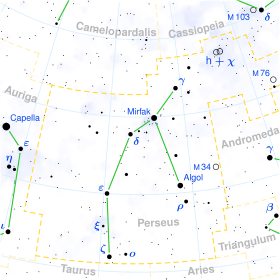Nu Persei
| Observation data Epoch J2000 Equinox J2000 | |
|---|---|
| Constellation | Perseus |
| Right ascension | 03h 45m 11.63204s[1] |
| Declination | 42° 34′ 42.7829″[1] |
| Apparent magnitude (V) | 3.80[2] |
| Characteristics | |
| Spectral type | F5II[3] |
| U−B color index | +0.28[2] |
| B−V color index | +0.42[2] |
| Astrometry | |
| Radial velocity (Rv) | -12.10[4] km/s |
| Proper motion (μ) | RA: -14.45[1] mas/yr Dec.: +2.53[1] mas/yr |
| Parallax (π) | 5.86 ± 0.22[1] mas |
| Distance | 560 ± 20 ly (171 ± 6 pc) |
| Absolute magnitude (MV) | -2.39[5] |
| Details | |
| Mass | 5.01[6] M☉ |
| Luminosity | 1491[6] L☉ |
| Surface gravity (log g) | 3.04[7] cgs |
| Temperature | 6,625[7] K |
| Metallicity [Fe/H] | +0.41[7] dex |
| Rotational velocity (v sin i) | 48.9[8] km/s |
| Other designations | |
| Database references | |
| SIMBAD | data |
Nu Persei (ν Per, ν Persei) is a Class F5,[3] fourth-magnitude star in the constellation Perseus. Nu Persei is a highly luminous yellow-white giant located about 555 light-years from Earth.[1]
Several companions beside the primary have been recorded. B, with magnitude 12.1 and separation 31.6", has its own companion, E, with magnitude 14.3 and separation 7.7". Additionally, C has magnitude 13.2 and separation 55.7", and D has magnitude 13.8 and separation 22.8".[9]
References
- 1 2 3 4 5 6 Van Leeuwen, F. (2007). "Validation of the new Hipparcos reduction". Astronomy and Astrophysics. 474 (2): 653. arXiv:0708.1752. Bibcode:2007A&A...474..653V. doi:10.1051/0004-6361:20078357. Vizier catalog entry
- 1 2 3 Ducati, J. R. (2002). "VizieR Online Data Catalog: Catalogue of Stellar Photometry in Johnson's 11-color system". CDS/ADC Collection of Electronic Catalogues. 2237. Bibcode:2002yCat.2237....0D.
- 1 2 Hoffleit, D.; Warren, W. H. (1995). "VizieR Online Data Catalog: Bright Star Catalogue, 5th Revised Ed. (Hoffleit+, 1991)". VizieR On-line Data Catalog: V/50. Originally published in: 1964BS....C......0H. 5050. Bibcode:1995yCat.5050....0H.
- ↑ Gontcharov, G. A. (2006). "Pulkovo Compilation of Radial Velocities for 35 495 Hipparcos stars in a common system". Astronomy Letters. 32 (11): 759. arXiv:1606.08053. Bibcode:2006AstL...32..759G. doi:10.1134/S1063773706110065.
- ↑ Anderson, E.; Francis, Ch. (2012). "XHIP: An extended hipparcos compilation". Astronomy Letters. 38 (5): 331. arXiv:1108.4971. Bibcode:2012AstL...38..331A. doi:10.1134/S1063773712050015. Vizier catalog entry
- 1 2 Hohle, M.M.; Neuhäuser, R.; Schutz, B.F. (2010). "Masses and luminosities of O- and B-type stars and red supergiants". Astronomische Nachrichten. 331 (4): 349. arXiv:1003.2335. Bibcode:2010AN....331..349H. doi:10.1002/asna.200911355. Vizier catalog entry
- 1 2 3 Earle Luck, R. (2014). "Parameters and Abundances in Luminous Stars". The Astronomical Journal. 147 (6): 137. Bibcode:2014AJ....147..137L. doi:10.1088/0004-6256/147/6/137.
- ↑ De Medeiros, J. R.; Mayor, M. (1999). "A catalog of rotational and radial velocities for evolved stars". Astronomy and Astrophysics Supplement Series. 139 (3): 433. arXiv:astro-ph/0608248. Bibcode:1999A&AS..139..433D. doi:10.1051/aas:1999401. Vizier catalog entry
- ↑ Mason, Brian D.; Wycoff, Gary L.; Hartkopf, William I.; Douglass, Geoffrey G.; Worley, Charles E. (2001). "The 2001 US Naval Observatory Double Star CD-ROM. I. The Washington Double Star Catalog". The Astronomical Journal. 122 (6): 3466. Bibcode:2001AJ....122.3466M. doi:10.1086/323920. Vizier catalog entry
This article is issued from
Wikipedia.
The text is licensed under Creative Commons - Attribution - Sharealike.
Additional terms may apply for the media files.
